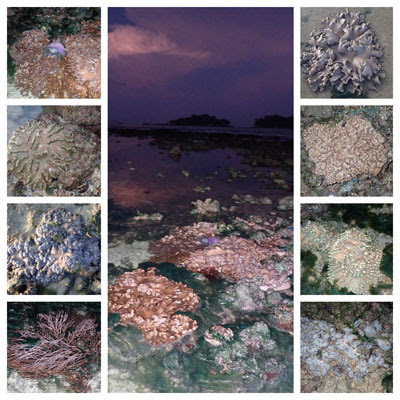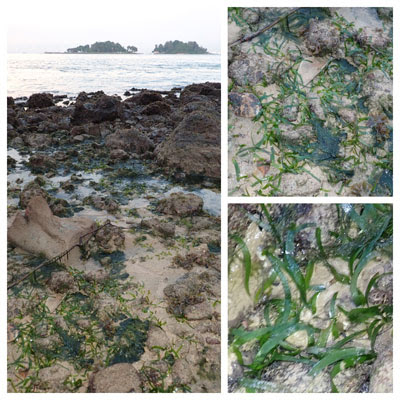Just minutes from the Central Business District, lies one of Singapore's last natural cliffs at St John's Island. The rocky shore and reef edge has corals and seagrasses. A small team visit early this morning to follow up on impact of mass coral bleaching last year.
Today, almost all the boulder Pore corals were bone white. But leathery soft corals and other kinds of corals were mostly alright. I'm not really sure what is happening. The rest of the team saw lots of interesting marine life. I will update when they have posted their photos.
Almost all the boulder Pore corals large and small were very pale. They were bone white and NOT glowing white as bleaching corals would do. This applied to those on the high shore and low shore. On the natural rocky reef, and those outside the swimming lagoon seawalls. A few other kinds of corals were also pale. One Barrel sponge was pale in the centre. I'm not really sure what is happening. During our last survey in Jun 2024, we estimate about 10% of hard corals were outright bleaching white, with another 20% showing stress (pale). About 5% of soft corals were outright bleaching, and about 10% showing slight stress (pale or very yellow patches).
The NOAA prediction for the Singapore Strait for sea temperatures suggest that the situation might get worse in the weeks ahead. Oh dear.
Not all the hard corals were pale or stressed. The cluster of Anemone corals just outside the swimming lagoons were still alright. There were also some medium sized Sandpaper corals which were okay - these are usually the first to bleach. Most of the boulder shaped Merulinid corals were okay. Some plate forming corals were also alright. There were a few small colonies of Galaxy coral, Cauliflower coral that were okay.
As in the past, I saw a wide variety of small to medium-sized colonies of leathery soft corals. Those I saw today seemed alright. I also saw two colonies of Leathery sea fan both were fine. During our survey in Jun 2024 for for impact of mass coral bleaching, 5% of leathery corals were outright bleaching white, and about 10% showing slight stress (pale or very yellow patches). As in the past, I didn't see any Flowery soft corals.
Other cnidarians can also bleach, so I looked out for those too. The Magnificent anemone population seemed to have exploded! I saw about 15 small ones near the reef edge, whereas on our last survey in Jun 2024, only a handful were seen. I saw many Giant carpet anemone throughout the rocky shores, none were bleaching - one small one had two large anemone shrimps! But I didn't see any 'Nemo's. Mathias saw some Frilly anemones. They all seemed fine. In the swimming lagoon, I saw Haddon's carpet anemone with bleached patches, and a Fire anemone that was fine. Large colonies of Sea mat zoanthids and small patches of other zoanthids were all fine.
The real treasures are the grandmother Nyireh laut tree and her daughters that grow on the western shore of St John's Island, which overlooks the Sisters and is part of the Sisters' Islands Marine Park. Nyireh laut is Critically Endangered in Singapore and we probably have only about 7 trees on our shores. There are another 3 on Sentosa Tg Rimau. We checked on them in Jun 2024 just after the Pasir Panjang oil spill, they were okay: no smell or stains of oil on their trunks, leaves still fresh and green. Today, they are still fine, although the large wooden pallet is still lodged near one of the daughter trees.
Inside the swimming lagoons, there are large patches of Spoon seagrass with small leaves, and some small patches of Needle seagrass with narrow leaves. There were also sprinkles of Spoon seagrass throughout the rest of the shores. They all looked fine.
On the Western shore facing Sisters Islands, there are still sprinkles of Sickle seagrass. Looking fresh and green and healthy.
Seagrasses here seem fine! Outside the seawall of the swimming lagoons, I saw about 20 clumps of Tape seagrass with long leaves (30-50cm) as well as many patches of Spoon seagrass - as I have in the past. They all looked fresh and green and healthy. Although none of those I saw were flowering. St John's Island is one of the few shores left that still has long Tape seagrass.
There appears to be a fresh landslide at the natural rocky shore area.
The St John's Island jetty is closed, probably for a year. Fortunately, we are able to make amphibious landing thanks to Alex!
St John's Island in the Singapore Blue Plan
The Singapore Blue Plan 2018 highlights the importance of St John's Island to our marine biodiversity. The cluster of Kusu, Lazarus and St. John's Islands has been recommended by the Singapore Blue Plan 2018 for elevated protection status.
The Blue Plan highlights that Lazarus, St. John’s, and Kusu Islands are established sites for coral nurseries as their shoreline offers ideal sheltered areas for growth of corals. Designating these islands as No-fishing Areas can bolster their rehabilitation. Protecting a larger cluster of islands means zonation plans for use can be implemented to manage tourism and human impacts.
DOWNLOAD the Plan, SUPPORT the Plan! More on the Singapore Blue Plan 2018 site.
Mathias Luk
Low Liong Leong
Others on this survey: Ian Mum.













